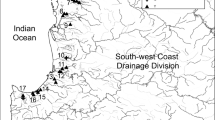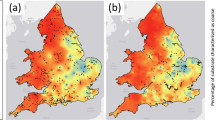Abstract
The zebra mussel Dreissena polymorpha was introduced to North America during the mid-1980s, and is now a dominant member of many benthic communities in the lower Great Lakes. In this study, I explored the abundance, biomass, size structure and settlement of Dreissena inhabiting rocks along a wave-swept disturbance gradient near Middle Sister Island in western Lake Erie. Ten rocks were collected from quadrats at six sites along each of three transect lines oriented perpendicular to shore. Occurrence, abundance and biomass of Dreissena on smaller, movable rocks were positively associated with rock distance from shore (∼lake depth) and with rock area; rocks at nearshore sites supported little, if any, Dreissena, whereas those at offshore sites were heavily colonized. Mussel size distributions also differed in relation to shore distance. Large mussels (≥19 mm) were underrepresented or absent on rocks collected at nearshore sites, but were overrepresented at offshore locations (≥37 m). Settlement of larval mussels on settling pads was positively correlated with distance offshore and with time of exposure, though settlement was substantial even at a nearshore (10 m) location. Area-adjusted mussel dry mass increased more rapidly with distance offshore on large than on small rocks. Large rocks also required more force to displace and were significantly less likely to be disturbed when transplanted at the study site. Results from this study indicate that occurrence, abundance and size structure of Dreissena in nearshore waters of Lake Erie correspond with the frequency of habitat disturbance, though other factors including food limitation and larval supply may also contribute to these patterns. These patterns complement studies that established the significance of physical disturbance in other aquatic systems.
Similar content being viewed by others
References
Ackerman JD, Cottrell CM, Ethier CR, Allen DG, Spelt JK (1995) A wall jet to measure the attachment strength of zebra mussels. Can J Fish Aquat Sci 52: 126–135
Barton DR, Hynes HBN (1978a) Wave-zone macrobenthos of the exposed Canadian shores of the St. Lawrence Great Lakes. J Great Lakes Res 4:27–45
Barton DR, Hynes HBN (1978b) Seasonal study of fauna of bedrock substrates in the wave-zone of Lakes Huron and Erie. Can J Zool 56:48–54
Black R, Peterson CH (1987) Biological vs. physical explanations for the non-random patterns of host occupation by a macroalga attaching to infaunal bivalve molluscs. Oecologia 73: 213–221
Dayton PK (1971) Competition, disturbance, and community organization: The provision and subsequent utilization of space in a rocky intertidal community. Ecol Monogr 41: 351–389
Denny MW, Daniel TL, Koehl MAR (1985) Mechanical limits to size in wave-swept environments. Ecol Monogr 55:69–102
Ewins PJ, Weseloh DV, Blokpoel H (1995) Assessing the impact of Dreissenid mussel colonization of Lake Erie on breeding populations of colonial fish-eating birds. In: International Association of Great Lakes Research, 38th conference, Ann Arbor. p63
French JRP III, Bur MT (1993) Predation of the zebra mussel (Dreissena polymorpha) by freshwater drum in western Lake Erie. In: Nalepa, TF, Schloesser DW (eds) zebra mussels. Biology, impacts, and control. Lewis, Boca Raton, pp 453–464
Gaines SD, Bertness MD (1992) Dispersal of juveniles and variable recruitment in sessile marine species. Nature 360:579–580
Griffiths RW, Schloesser DW, Leach JH, Kovalak WP (1991) Distribution and dispersal of the zebra mussel (Dreissena polymorpha) in the Great Lakes region. Can J Fish Aquat Sci 48:1381–1388
Grosberg RK, Levitan DR (1992) For adults only? Supply-side ecology and the history of larval biology. Trends Ecol Evol 7:130–133
Hamilton DJ, Ankney D, Bailey RC (1994) Predation of zebra mussels by diving ducks: an enclosure study. Ecology 75:521–531
Inglis GJ (1994) Contrasting effects of habitat structure on the recruitment and mortality of an epibiotic macroalga. Oecologia 99:352–365
Lewandowski K (1976) Unionidae as a substratum for Dreissena polymorpha Pall. Pol Arch Hydrobiol 23:409–420
Lewandowski K, Stańczykowska A (1986) Ecology of the storage revervoir of a pumped-storage power station. VI. Molluscs in Lake Zarnowiekie. Pol Ecol Stud 12:315–330
Lind OT (1979) Handbook of common methods in limnology, 2nd edn. Moseby, St. Louis
MacIsaac HJ, Sprules WG, Johannsson OE, Leach JH (1992) Filtering impacts of larval and sessile zebra mussels (Dreissena polymorpha) in western Lake Erie. Oecologia 92:30–39
Martel A (1993) Dispersal and recruitment of zebra mussel (Dreissena polymorpha) in a nearshore area in west-central Lake Erie: the significance of post-metamorphic drifting. Can J Fish Aquat Sci 50:3–12
Martel A (1994) Daily settlement rates of the zebra mussel, Dreissena polymorpha, on an artificial substrate correlate with veliger abundance. Can J Fish Aquat Sci 51:856–861
Mazak E (1995) Organic contaminants of lower Great Lakes' waterfowl in relation to diet, with particular reference to Dreissena polymorpha. MSc thesis, University of Windsor, Ontario, Canada
McGrorty S, Clarke RT, Reading CJ, Goss-Custard JD (1990) Population dynamics of the mussel Mytilus edulis: density changes and regulation of the population in Exe estuary, Mar Ecol Prog Ser 67:157–169
McGuiness KA (1987) Disturbance and organisms on boulders. I. Patterns in the environment and the community. Oecologia 71:409–419
Menge BA (1991) Relative importance of recruitment and other causes of variation in rocky intertidal community structure. J Exp Mar Biol Ecol 146:69–100
Menge BA, Sutherland JP (1987) Community regulation: variation in disturbance, competition, and predation in relation to environmental stress and recruitment. Am Nat 130:730–757
Minchinton TE, Scheibling RE (1991) The influence of larval supply and settlement on the population structure of barnacles. Ecology 72:1867–1879
Nehls G, Thiel M (1993) Large-scale distribution patterns of the mussel Mytilus edulis in the Wadden Sea of Schleswig-Holstein: do storms structure the ecosystem? Neth J Sea Res 31:181–187
Osman RW (1977) The establishment and development of a marine epifaunal community. Ecol Monogr 47:37–63
Paine RT (1974) Intertidal community structure. Experimental studies on the relationship between a dominant competitor and its principal predator. Oecologia 15: 93–120
Paine RT, Levin SA (1981) Intertidal landscapes: disturbance and the dynamics of pattern. Ecol Monogr 51:145–178
Peterson CH, Summerson HC (1992) Basin-scale coherence of population dynamics of an exploited marine invertebrate, the bay scallop: implications of recruitment limitation. Mar Ecol Prog Ser 90:257–272
Reice SR (1980) The role of substratum in benthic macroinvertebrate microdistribution and litter decomposition in a woodland stream. Ecology 61:580–590
Resh VH, Brown AV, Covich AP, Gurtz ME, Li HW, Minshall GW, Reice SR, Sheldon AL, Wallace JB, Wissmar RC (1988) The role of disturbance in stream ecology. J N Am Benthol Soc 7:433–455
Roughgarden J, Pennington T, Alexander S (1994) Dynamics of the rocky intertidal zone with remarks on generalizations in ecology. Philos Trans R Soc Lond B 343:79–85
Sokal RR, Rohlf FJ (1981) Biometry, 2nd edn. Freeman, New York
Sousa WP (1979) Disturbance in marine intertidal boulder fields: the nonequilibrium maintenance of species diversity. Ecology 60:1225–1239
Sousa WP (1984) The role of disturbance in natural communities. Annu Rev Ecol Syst 15:353–391
Sprung M, Rose U (1988) Influence of food size and food quantity on the feeding of the mussel Dreissena polymorpha. Oecologia 77:526–532
Underwood AJ, Denley EJ (1984) Paradigms, explanations, and generalizations in models for the structure of intertidal communities on rocky shores. In: Strong DR Jr, Simberloff D, Abele LG, Thistle AB (ed) Ecological communities: conceptual issues and the evidence. Princeton University Press, Princeton, pp 151–180
Witman JD, Suchanek TH (1984) Mussels in flow: drag and dislodgement by epizoans. Mar Ecol Prog Ser 16:259–268
Wormington A, Leach JH (1992) Concentrations of migrant diving ducks at Point Pelee National Park, Ontario, in response to invasion of zebra mussels, Dreissena polymorpha. Can Field Nat 106:376–380
Zar JH (1984) Biostatistical analysis. Prentice-Hall, Englewood Cliffs
Author information
Authors and Affiliations
Rights and permissions
About this article
Cite this article
MacIsaac, H.J. Population structure of an introduced species (Dreissena polymorpha) along a wave-swept disturbance gradient. Oecologia 105, 484–492 (1996). https://doi.org/10.1007/BF00330011
Received:
Accepted:
Issue Date:
DOI: https://doi.org/10.1007/BF00330011




